Navigation Menu...
-
Reach Us
+91-94142-34143
abhaytravels@gmail.com -
Reach Us
+91-94142-34143
abhaytravels@gmail.com
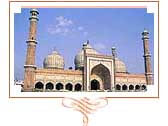 Delhi :
The capital and the third largest city of
India is a fusion of the ancient and the modern. Standing along the West End ofGangetic Plain, the capital city, Delhi, unwinds a picture rich with
culture, architecture and human diversity, deep in history, monuments,
museums, galleries, gardens and exotic shows. Comprising of two contrasting
yet harmonious parts, the Old Delhi and New Delhi, the city is a travel hub
of Northern India.
Delhi :
The capital and the third largest city of
India is a fusion of the ancient and the modern. Standing along the West End ofGangetic Plain, the capital city, Delhi, unwinds a picture rich with
culture, architecture and human diversity, deep in history, monuments,
museums, galleries, gardens and exotic shows. Comprising of two contrasting
yet harmonious parts, the Old Delhi and New Delhi, the city is a travel hub
of Northern India.
Narrating the city's Mughal past, Old
Delhi, takes you through the labyrinthine streets passing through formidable
mosques, monuments and forts. You will also discover lively and colorful
bazaars that boast to cater all sorts of good and items at mind-blowing
prices amidst a barely controlled chaotic ambience. The imperial
city of New Delhi displays the finely curved architecture of British Raj.
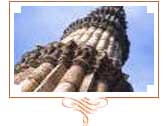 Qutab Minar : It is a soaring, 73 m-high tower of victory, built in 1193 by Qutab-ud-din Aibak immediately after the defeat of Delhi's last Hindu kingdom. The tower has five distinct storeys, each marked by a projecting balcony and tapers from a 15 m diameter at the base to just 2.5 m at the top. The first three storeys are made of red sandstone; the fourth and fifth storeys are of marble and sandstone. At the foot of the tower is the Quwwat-ul-Islam Mosque, the first mosque to be built in India. An inscription over its eastern gate provocatively informs that it was built with material obtained from demolishing '27 Hindu temples'. A 7 m-high iron pillar stands in the courtyard of the mosque. It is said that if you can encircle it with your hands while standing with your back to it your wish will be fulfilled.
Qutab Minar : It is a soaring, 73 m-high tower of victory, built in 1193 by Qutab-ud-din Aibak immediately after the defeat of Delhi's last Hindu kingdom. The tower has five distinct storeys, each marked by a projecting balcony and tapers from a 15 m diameter at the base to just 2.5 m at the top. The first three storeys are made of red sandstone; the fourth and fifth storeys are of marble and sandstone. At the foot of the tower is the Quwwat-ul-Islam Mosque, the first mosque to be built in India. An inscription over its eastern gate provocatively informs that it was built with material obtained from demolishing '27 Hindu temples'. A 7 m-high iron pillar stands in the courtyard of the mosque. It is said that if you can encircle it with your hands while standing with your back to it your wish will be fulfilled.
The origins of Qutab Minar are shrouded in controversy. Some believe it was erected as a tower of victory to signify the beginning of the Muslim rule in India. Others say it served as a minaret to the muezzins to call the faithful to prayer. No one can, however, dispute that the tower is not only one of the finest monuments in India, but also in the world. Qutab-ud-din Aibak, the first Muslim ruler of Delhi, commenced the construction of the Qutab Minar in 1200 AD, but could only finish the basement. His successor, Iltutmush, added three more storeys, and in 1368, Firoz Shah Tughlak constructed the fifth and the last storey.
The development of architectural styles from Aibak to Tughlak is quite evident in the minar. The relief work and even the materials used for construction differ. The 238 feet Qutab Minar is 47 feet at the base and tapers to nine feet at the apex. The tower is ornamented by bands of inscriptions and by four projecting balconies supported by elaborately decorated brackets. Even in ruin, the Quwwat Ui Islam (Light of Islam) Mosque in the Qutab complex is one of the most magnificent in the world. Qutab-ud-din Aibak started its construction in 1193 and the mosque was completed in 1197.
Iltutmush in 1230 and Alla-ud-din Khilji in 1315 made additions to the building. The main mosque comprises of an inner and outer courtyard, of which an exquisite colonnade, the pillars of which are made of richly, surrounds the inner decorated shafts. Most of these shafts are from the 27 Hindu temples, which were plundered to construct the mosque. It is, therefore, not surprising that the Muslim mosque has typical Hindu ornamentation. Close to the mosque is one of Delhi's most curious antiques, the Iron Pillar.
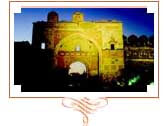 Purana Quila : One does not have to go far to see the old fort or Purans Quila standing stoically amidst wild greenery.Built on the site of the most ancient of the numerous cities of Delhi, Indraprastha, Purana Quila is roughly rectangular in shape having a circuit of nearly two kilometers. The thick ramparts crowned by merlons have three gateways provided with bastions on either side. It was surrounded by a wide moat, connected to river Yamuna, which used to flow on the east of the fort. The northern gate way, called the Talaqui darwaza or the forbidden gateway, combines the typically Isalmic pointed arch with Hindu Chhatris and brackets;whereas the southern gateway called the Humayun Darwaza also had a similar plan. The massive gateway and walls of Purana Quila were built by Humayun who laid his new capital Dinpanah in 1534 A.D. Sher Shah who defeated Humayun in1540 A.D. Purana Quila is the venue for the spectacular sound and light show held every evening built a few building in the complex. Adherents of any faith are free to visit the temple and pray or meditate. Around the blooming petals there are nine pools of water, which light up, in natural light. It looks spectacular at dusk when it is flood lit.
Purana Quila : One does not have to go far to see the old fort or Purans Quila standing stoically amidst wild greenery.Built on the site of the most ancient of the numerous cities of Delhi, Indraprastha, Purana Quila is roughly rectangular in shape having a circuit of nearly two kilometers. The thick ramparts crowned by merlons have three gateways provided with bastions on either side. It was surrounded by a wide moat, connected to river Yamuna, which used to flow on the east of the fort. The northern gate way, called the Talaqui darwaza or the forbidden gateway, combines the typically Isalmic pointed arch with Hindu Chhatris and brackets;whereas the southern gateway called the Humayun Darwaza also had a similar plan. The massive gateway and walls of Purana Quila were built by Humayun who laid his new capital Dinpanah in 1534 A.D. Sher Shah who defeated Humayun in1540 A.D. Purana Quila is the venue for the spectacular sound and light show held every evening built a few building in the complex. Adherents of any faith are free to visit the temple and pray or meditate. Around the blooming petals there are nine pools of water, which light up, in natural light. It looks spectacular at dusk when it is flood lit.
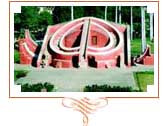 Jantar Mantar : It was constructed in 1724. Maharaja Jai Singh of Jaipur
who built this observatory went on to build other observatories
in Ujjain , Varanasi and Mathura. Jai Singh had found the
existing astronomical instruments too small to take correct
measurements and so he built these larger and more accurate
instruments. The instruments at Jantar Mantar are fascinating
for their ingenuity, but accurate observations can no longer be
made from here because of the tall buildings around.
Jantar Mantar : It was constructed in 1724. Maharaja Jai Singh of Jaipur
who built this observatory went on to build other observatories
in Ujjain , Varanasi and Mathura. Jai Singh had found the
existing astronomical instruments too small to take correct
measurements and so he built these larger and more accurate
instruments. The instruments at Jantar Mantar are fascinating
for their ingenuity, but accurate observations can no longer be
made from here because of the tall buildings around.
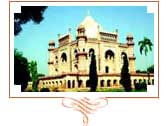 Safdarjung's Tomb : Safdarjung's Tomb is the last enclosed garden tomb in
Delhi in the tradition of Humayun's Tomb, though it if far less
grand in scale. It was built in 1753- 54 as mausoleum of
Safdarjung, the viceroy of Awadh under the Mughal Emperor,
Mohammed Shah. It has several smaller pavilions with evocative
names like Jangli Mahal, (Palace in the woods),Moti Mahal (Pearl
Palace) and Badshah Pasand ( King's favourite). The complex
also has a madarsa. The archaeologocal Survey of India maintains
a library over the main gateway.
Safdarjung's Tomb : Safdarjung's Tomb is the last enclosed garden tomb in
Delhi in the tradition of Humayun's Tomb, though it if far less
grand in scale. It was built in 1753- 54 as mausoleum of
Safdarjung, the viceroy of Awadh under the Mughal Emperor,
Mohammed Shah. It has several smaller pavilions with evocative
names like Jangli Mahal, (Palace in the woods),Moti Mahal (Pearl
Palace) and Badshah Pasand ( King's favourite). The complex
also has a madarsa. The archaeologocal Survey of India maintains
a library over the main gateway.
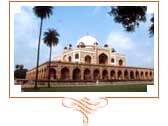 Humayun Tomb :
Located
near the crossing of Mahura road and Lodhi road, this
magnificent garden tomb is the first substantial example of
Mughal architecture in India. It was buit in 1565 A.D.nine years
after the death of Humayun, by his senior widow Bega Begam.
Inside the walled enclosure the most notable feature are the
garden squares (chaharbagh) with pathways water channels,
centrally located well proportional mausoleum topped by double
dome.
Humayun Tomb :
Located
near the crossing of Mahura road and Lodhi road, this
magnificent garden tomb is the first substantial example of
Mughal architecture in India. It was buit in 1565 A.D.nine years
after the death of Humayun, by his senior widow Bega Begam.
Inside the walled enclosure the most notable feature are the
garden squares (chaharbagh) with pathways water channels,
centrally located well proportional mausoleum topped by double
dome.
Duration wise | Destination wise
